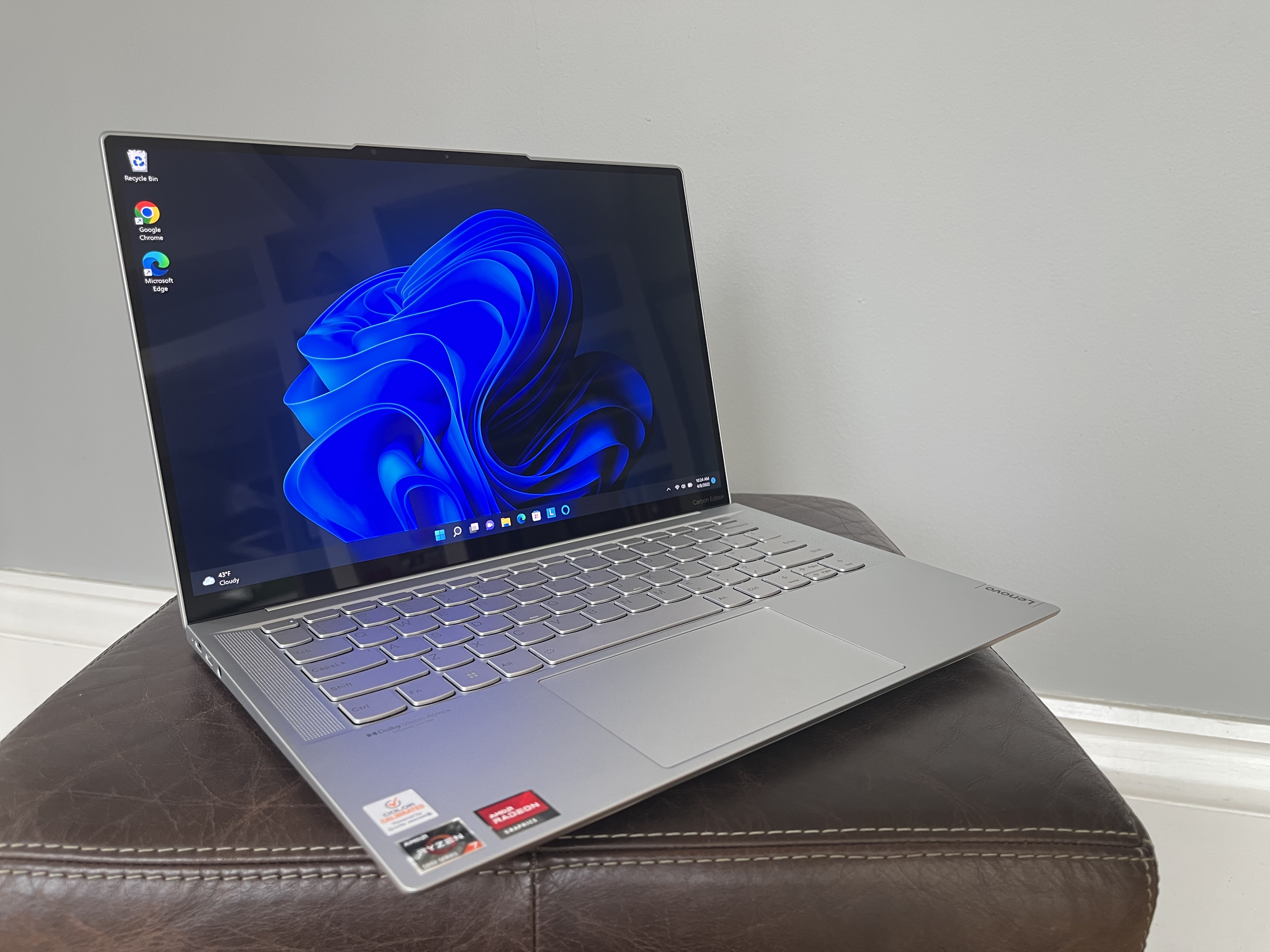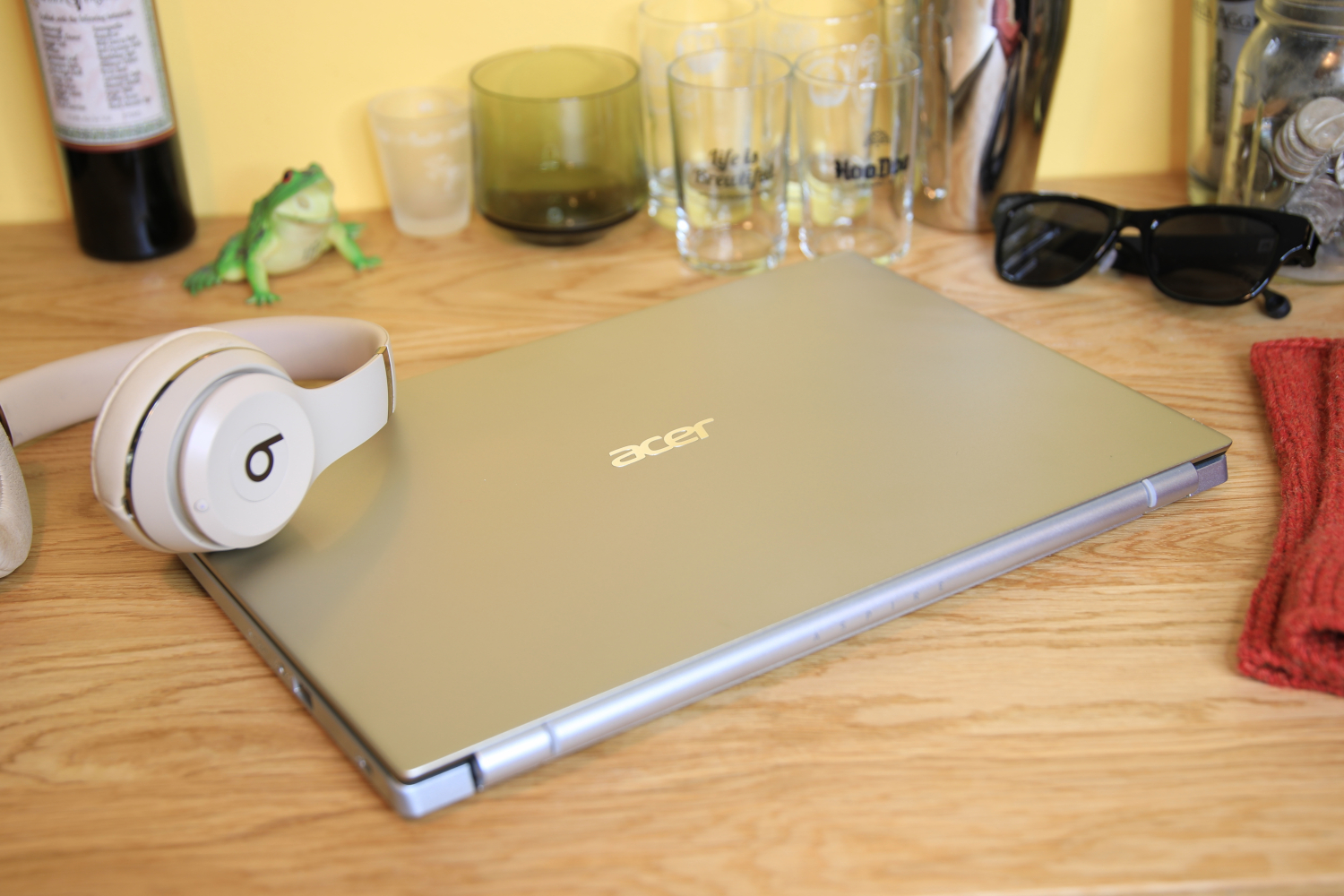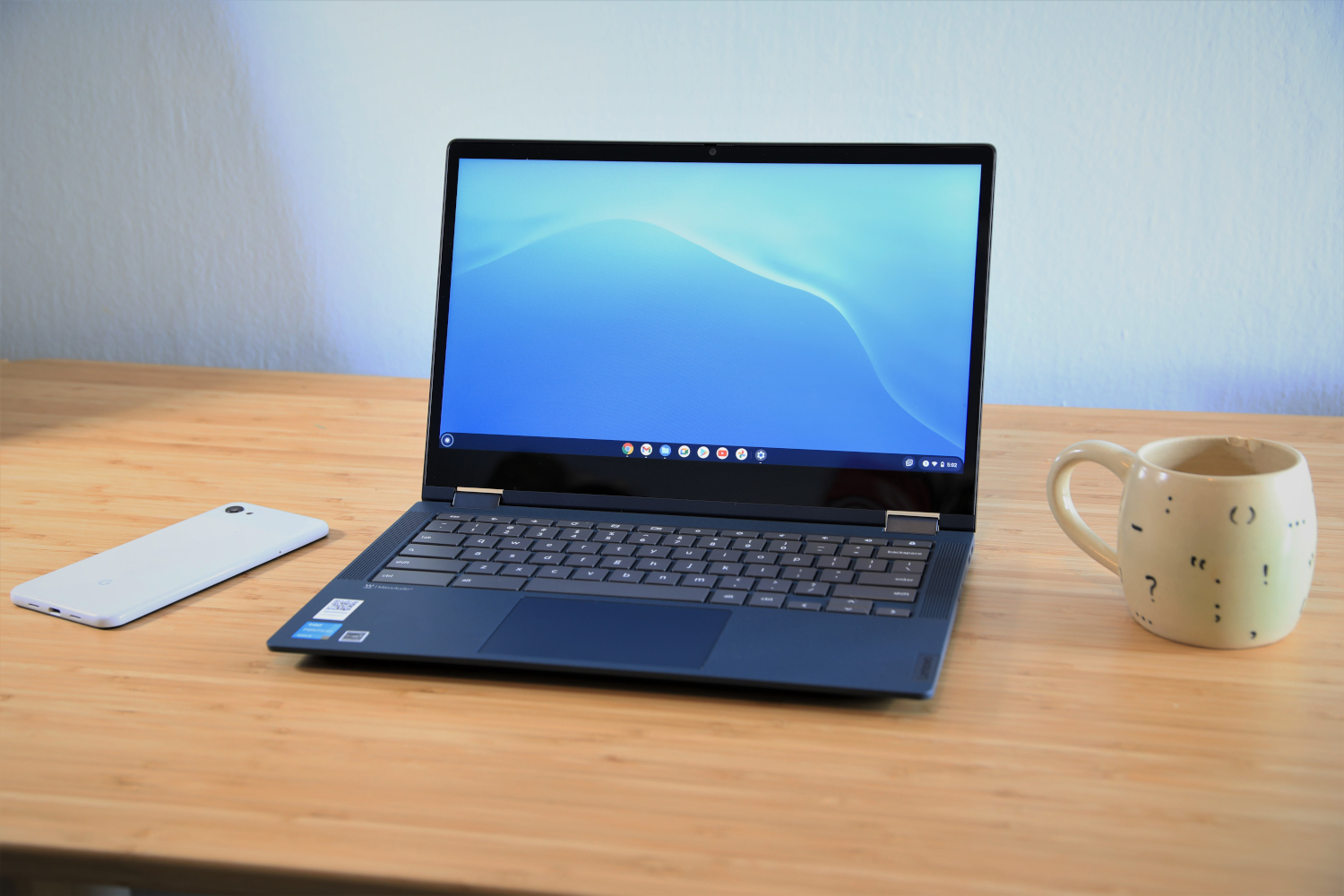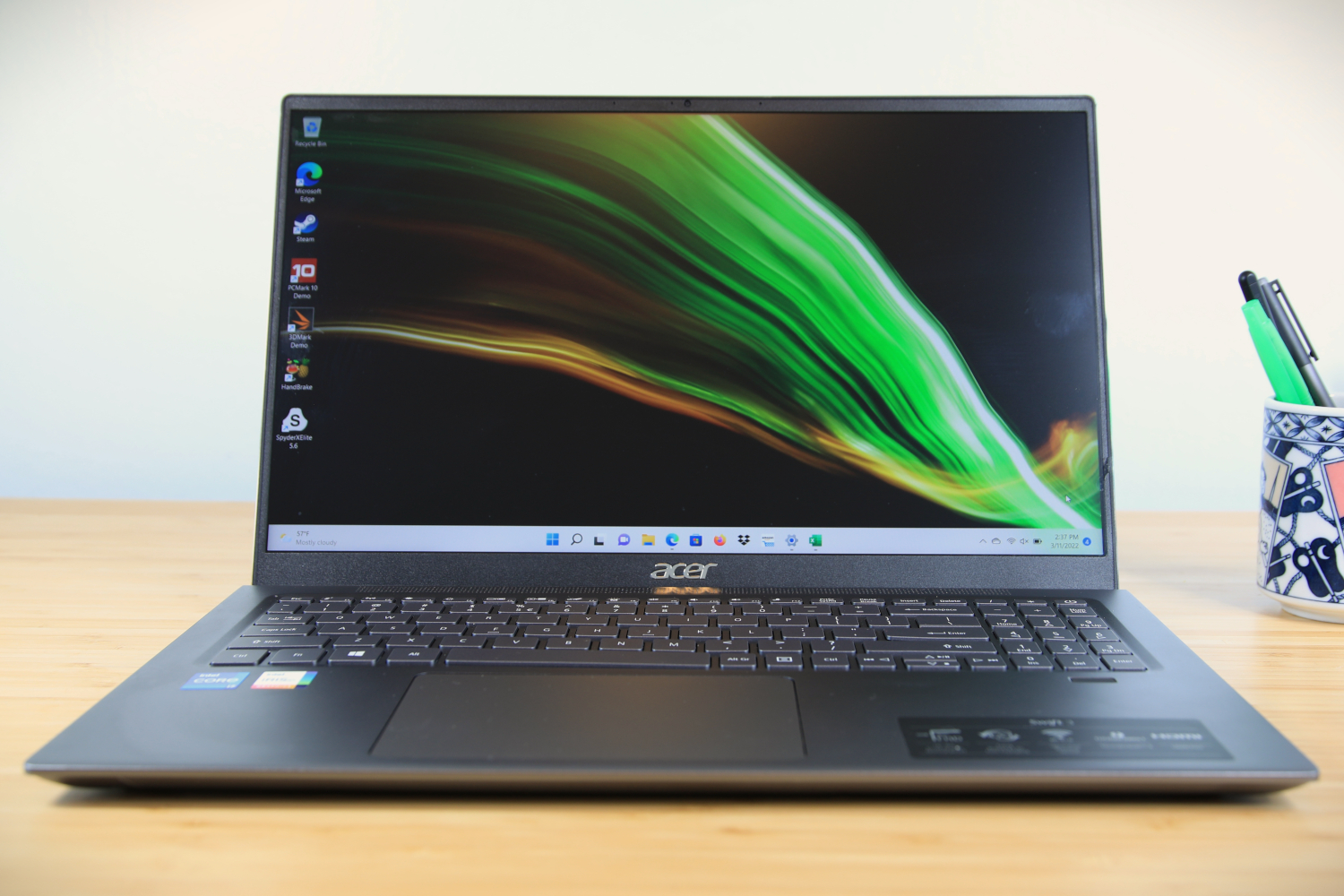Each year, laptops improve across the board—between technology advances and competitive pressures, the hardware inside offers better performance in ever greater leaps and bounds.
That means you don’t need to drop a ton of cash on a premium model to get a solid laptop. Whether you’re talking about a traditional Windows clamshell or a fully loaded Chromebook, spending between $600 and $1,000 can get you a laptop you’ll enjoy using. Moreover, its battery will last the length of the work or school day without trouble.
Enough options exist now that finding the right model for you can take some time, so we’ve highlighted our top picks to make the hunt fast and easy. Read on to find your match. (To find laptop recommendations that span all price ranges, see our comprehensive guide to the best laptops).
Lenovo IdeaPad Slim 7 Carbon – Best overall under $1,000

Pros
- 2.8K OLED display is gorgeous
- Booming audio
- Quiet operation
- Strong application and multimedia performance
Cons
- So-so keyboard
- Lid is so thin it flexes a bit too much
- Below-average battery life
From zippy multimedia performance to punchy audio, the Lenovo IdeaPad Slim 7 Carbon has a lot to offer at a reasonable price point. The real star of the show is the 14-inch 2880×1800 OLED display. According to the reviewer, “the contrast is outstanding, with the deepest blacks and brightest whites.” As for colors, they’re “accurate and noticeably vibrant.” The screen is a perfect fit for creative professionals who do a lot of photo editing. In addition to its stunning panel, the laptop also weighs just a little over 2 pounds, making it a capable travel laptop. There are a few minor shortcomings, though. The keyboard isn’t the best and battery life is less than stellar. But in the end, the pros really outweigh the cons here.
Read our full
Lenovo IdeaPad Slim 7 Carbon review
Acer Aspire 5 – Best under $500

Pros
- Affordable price
- Rugged build
- Great keyboard
- Good selection of ports
Cons
- Subpar webcam
- Annoying bloatware comes pre-installed
- Touchpad is a little hard to us
MSRP:
$369 (base model) $499 (as reviewed)
With its affordable price point, decent performance, and robust build, the Acer Aspire 5 is an excellent sub-$500 option. Our tester was surprised by its “solid, durable feel.” Although it lacks backlighting, the keyboard is quite nice. It has a spacious layout, which is perfect for longer typing sessions. Performance is fast enough for general-use tasks like writing emails and browsing the web, but that’s about it. If you’re shopping around for a solid everyday laptop that won’t break the bank, the Aspire 5 is definitely worth a look.
Read our full
Acer Aspire 5 review
Lenovo Chromebook Flex 5 – Best Chromebook

Pros
- Attractive design
- Affordable
- Punchy audio
- Excellent keyboard
Cons
- Mediocre performance
- Subpar battery life
The Lenovo Chromebook Flex 5 is a good mid-range Chromebook. It’s fast enough for web browsing, editing documents, and so on. That said, it can “feel taxed by demanding tasks.” When our tester opened up multiple tabs, he noticed a sag in performance. The port selection, however, is nice combination of old and new. It has two USB-C ports, a single USB-A port, a 3.5mm combo audio jack, and a microSD card reader. As for the keyboard, our tester liked the “crisp and taut” feel of the keys. Although this laptop is a 2-in-1—meaning the screen can fold back to make it function more like a tablet—it weighs about 3 pounds, which is on the heavier side for a convertible laptop. It may not be the most portable laptop in the world, but that flexibility can still be nice for applications that favor a tablet form factor.
Read our full
Lenovo Chromebook Flex 5 review
HP Chromebook x2 11 da0023dx – Best folio-style Chromebook

Pros
- Gorgeous 2K touchscreen
- Solid performance
- Excellent battery life
- Robust design
Cons
- Trackpad is too sensitive at times
- Light on ports
Ah, folio-style laptops. While some may find the detachable-keyboard design a pain to deal with, our reviewer really liked this one. The HP Chromebook x2 11 is one of the best 2-in-1 laptops you can buy. The tablet’s aluminum chassis feels rugged and like it’ll last quite a while. The detachable keyboard took some getting used to, but ended up being fine for long typing sessions. The rear plate, which transforms into a kickstand that holds up the tablet for hands-free use, connects to the back of the tablet via magnets. The reviewer found the connection to be both clean and strong. As for the performance, it’s about what you’d expect out of a Chromebook. It’s zippy enough for everyday tasks like browsing the web and so on.
Read our full
HP Chromebook x2 11 da0023dx review
Acer Swift 3 – Best for college students

Pros
- Solid chassis and build quality
- Large, attractive 16-inch 1080p screen
- Enjoyable keyboard and touchpad
- USB-C with charging and DisplayPort
Cons
- Webcam, microphone, and speakers don’t impress
- Intel processor falls behind AMD alternatives
- Disappointing battery life
- Lots of bloatware
If you’re a college student working with a modest budget, the Acer Swift 3 is a fantastic option. It features an attractive 16-inch 1080p display, a solid chassis, and an enjoyable keyboard and touchpad. However, battery life is subpar, so you’ll want to keep the charger on hand. This is unfortunate, as the Swift 3’s slim profile makes it a good laptop for travel. If you don’t mind the lackluster battery life, this is a great laptop for watching movies and writing research papers on.
Read our full
Acer Swift 3 review
How we tested
The PCWorld team puts each and every Windows laptop through a series of benchmarks that test GPU and CPU performance, battery life, and so on. The idea is to push the laptop to its limits and then compare it against others we’ve tested. Chromebooks, on the other hand, go through a series of web-based tests. It wouldn’t be fair or possible to run the same kinds of tests on a Chromebook, as they’re Chrome OS-based machines. Below, you’ll find a breakdown of each test and the reasons why we run them.
Windows laptops
- PCMark 10: PCMark 10 is how we determine how well the laptop handles lighter tasks like web browsing, word processing, spreadsheets, and so on.
- HandBrake: HandBrake is more intensive than PCMark 10. It basically measures how long a laptop’s CPU takes to encode a beefy 30GB file.
- Cinebench: Cinebench is a brief stress test of the CPU cores. It does this by rendering a 2D scene over a short period of time.
- 3DMark: 3DMark checks if 3D performance remains consistent over time by running graphic-intensive clips.
- Video rundown test: To gauge battery life, we loop a 4K video using Windows 10’s Movies & TV app until the laptop dies.
Chromebooks
- CrXPRT 2: The CrXPRT 2 benchmark tests a Chromebook’s battery life.
- Speedometer 2.0: This test determines a Chromebook’s web browser performance. It simulates this by adding, completing, and removing a to-do list.
- Basemark Web 3.0: This benchmark gauges how well a Chromebook can handle web-based applications.
- Kraken 1.1: Kraken 1.1 is a JavaScript performance benchmark.
- Jetstream 2: Jetstream 2 is a combination of WebAssembly and JavaScript benchmarks. This is a way to gauge how well a Chromebook runs advanced workloads.
What kind of laptop should you get?
Ah, here we are at the billion dollar question. Do you spring for a basic Chromebook or go for a Windows laptop with more features? Well, it really depends on your personal lifestyle and what you plan on using your laptop for. For example, Chromebooks are a great low cost option for those who just want the basics. I use a Chromebook as my primary work laptop, as it has everything I need for both editing and writing. If you travel a bunch for work, it’s probably a good idea to invest in a laptop with solid battery life. If you’re still unsure, don’t sweat it. I’ve put together a list of quick tips below.
- Laptop type: The first question you should ask yourself is what kind of laptop you’re looking for. There’s traditional clamshells, 2-in-1’s, Chromebooks, and much more. The displays on convertible laptops (aka 2-in-1’s), for example, can swing around 360 degrees. This allows you to use the laptop like a tablet. They can also be propped up like a tent for viewing movies or participating in video calls. Chromebooks, on the other hand, exclusively run Google’s web-focused Chrome OS and are generally used for everyday tasks. All you need is a Gmail account and boom, you’re in. There are pros and cons to each of them. Chromebooks are affordable and generally have good battery life whereas convertibles are normally lightweight and portable.
- CPU: If it’s CPU power you’re looking for, look for processors with higher numerical names. A Core i7 is more suited to gaming and more intense work than everyday tasks. Intel processors are available in Core i3, Core i5, Core i7, and Core i9. The higher the number, the more powerful the CPU. If you don’t need a ton of power, Intel Core i5 processors are your best bet, as they offer good performance at a decent price. Basic office and web work gets along just fine on a Core i3. As for AMD options, the Ryzen 3 is good for basic productivity and web browsing, while Ryzen 5 chips rival Intel’s Core i5 as solid all-arounders. If you need more power, the Ryzen 7 chip is well suited for content creation like video editing. Finally, if you’re dealing with 4K video, spring for a Ryzen 9.
- Graphics: You’ll want a discrete graphics card for hardcore gaming or editing videos. It’s separate from the processor, so you can expect higher performance out of it. Integrated graphics, on the other hand, are attached to the CPU and uses less power as a result. This is perfectly fine for everyday tasks, especially if you’re not doing anything that’s graphics-intensive.
- RAM: 8GB of RAM is zippy enough for general use. If you’ve got a gaming laptop, 16GB of RAM is the way to go, and content creators will want even more.
- Display size: If you’re a video editor or someone who does a lot of multimedia work, you’ll want a display that’s anywhere from 15 to 17 inches. The sweet spot is really anywhere from 13 to 14 inches, though. The bigger the display, the heavier your laptop is going to be. A 13- or 14-inch display is the best in terms of portability and value.
- Battery life: If you plan on taking your laptop anywhere with you, aim for something that can last 10 to 12 hours on a single charge. That’s more than a full work day, so it should theoretically get you through long flights or a day of classes. Obviously, more is always better. Just know that the bigger the battery, the heavier the laptop.
- Price: The price really depends on your budget. If you’re strapped for cash (been there, trust me), go for a Chromebook or an entry-level business laptop. These laptops are a good choice for students or young professionals. If you can afford to spend more, the versatility of a 2-in-1 laptop is really worth it.
- Ports: A wide array of ports is always a plus in my book, as it eliminates the need for an adapter. I’d recommend a laptop that has both USB-C and USB-A. An HDMI port is good, too. This is especially useful for hooking up to an external monitor.




